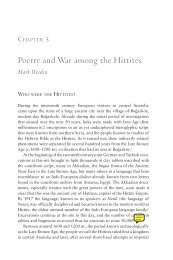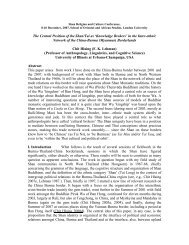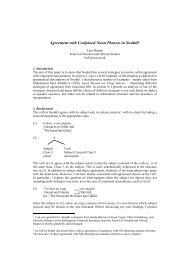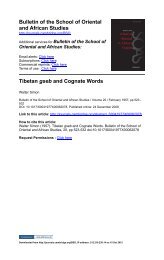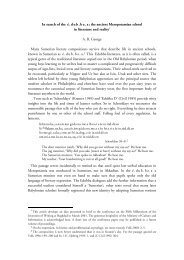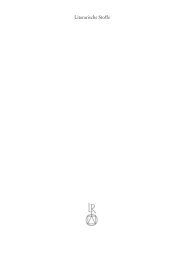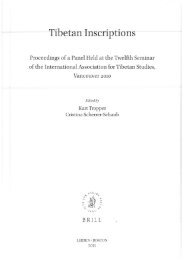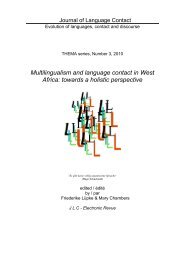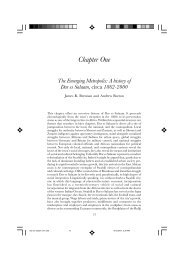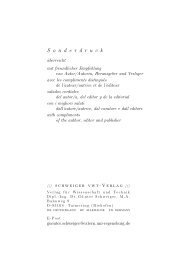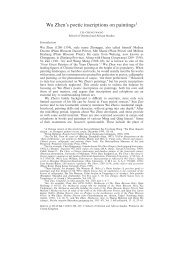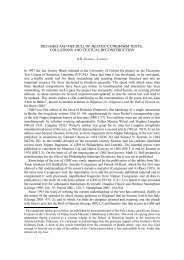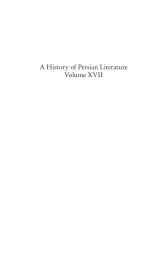PDF (pre-publication proofs) - The School of Oriental and African ...
PDF (pre-publication proofs) - The School of Oriental and African ...
PDF (pre-publication proofs) - The School of Oriental and African ...
Create successful ePaper yourself
Turn your PDF publications into a flip-book with our unique Google optimized e-Paper software.
Altoriental. Forsch., Akademie Verlag, 38 (2011) 1, 116–134<br />
Mark Weeden<br />
Hittite Scribal <strong>School</strong>s Outside <strong>of</strong> Hattusa?<br />
Abstract<br />
<strong>The</strong> article investigates the meagre textual evidence for Hittite scribal schools outside <strong>of</strong> Hattusa against<br />
the background <strong>of</strong> new excavations <strong>and</strong> the questions they raise about the social context <strong>of</strong> Hittite cuneiform<br />
writing. <strong>The</strong> use <strong>of</strong> the term é.dub.ba(.a) in Late Bronze Age Anatolia by contrast to Middle<br />
Bronze Age Babylonia is briefly touched on, <strong>and</strong> the institution <strong>of</strong> the é gisˇ.kin.ti at Karahna is compared<br />
with that at Hattusa*.<br />
Keywords: Scribal school, Bog˘azköy, Ortaköy, Mas¸at, social context <strong>of</strong> cuneiform writing, temple.<br />
Cuneiform among the Hittites<br />
Only in recent years has the study <strong>of</strong> Hittite school institutions <strong>and</strong> programs begun to gain<br />
momentum. Special mention should be given to the studies <strong>of</strong> Giulia Torri concerning the<br />
distribution <strong>of</strong> text-types <strong>and</strong> writing personnel recorded on tablets in the lower-city at<br />
Hattusa, especially the Haus am Hang, <strong>and</strong> also to those <strong>of</strong> Shai Gordin, investigating the<br />
prosopographical relationships between individual scribes <strong>and</strong> the possible institutional<br />
frameworks for such relationships. In these cases the focus has thus far been on the Haus<br />
am Hang <strong>and</strong> the possible é gisˇ.kin.ti in the Südareal south <strong>of</strong> Temple I, which have both<br />
been held to have been scribal schools or scriptoria within the city <strong>of</strong> Hattusa 1 .<br />
At the same time the text-finds from sites other than Bog˘azköy are beginning to<br />
multiply, prompting consideration <strong>of</strong> the social <strong>and</strong> geographic distribution <strong>of</strong> Hittite<br />
cuneiform writing in Anatolia, although this must be said to be a process that is in its<br />
infancy due to the current state <strong>of</strong> finds <strong>and</strong>/or <strong>publication</strong>. In the following I would like to<br />
consider evidence for Hittite scribal schools outside <strong>of</strong> Hattusa. It has to be said that there<br />
is currently not much published evidence, but it is not too early to begin the discussion.<br />
I will consider direct references to scribal institutions as they are found in available cuneiform<br />
texts, <strong>and</strong> I will concentrate on the texts <strong>of</strong> the central Anatolian area, as these<br />
*<strong>The</strong> article has benefited from comments gratefully received from Joost Hazenbos <strong>and</strong> Jared Miller <strong>of</strong><br />
the editorial board at AoF.<br />
1 Torri (2008; 2009); Gordin (2010; 2011).
Altoriental. Forsch. 38 (2011) 1 117<br />
<strong>pre</strong>sent a unified whole, with strikingly uniform sign-forms <strong>and</strong> regularity <strong>of</strong> sign-values. So<br />
unified is the script <strong>of</strong> finds <strong>of</strong> Hittite texts from outside Bog˘azköy in central Anatolia, that<br />
one might assume a centralised education in writing.<br />
Hittite texts from Syrian centres such as Alalakh 2 , Emar 3 <strong>and</strong> Ugarit 4 , frequently<br />
<strong>pre</strong>sent anomalies in orthography, phonotactics <strong>and</strong> script which are not to be found in<br />
texts from the Central Anatolian Area, oddities which may in large part be due to the<br />
influence <strong>of</strong> local scribal traditions, possibly dominated from the Hittite chancellery at<br />
Karkamisˇ.This also applies to the Sammeltafel <strong>of</strong> texts “made in the manner <strong>of</strong> Arusna”,<br />
that Jared Miller has recently <strong>pre</strong>sented at two conferences 5 . It displays numerous orthographic<br />
peculiarities not otherwise found at Hattusa, some <strong>of</strong> which may be explained as<br />
being the result <strong>of</strong> school traditions closer to those found in Syria 6 . Much further research<br />
is needed on this topic.<br />
It can be argued that a fundamental sociological difference exists between the Hittite use<br />
<strong>of</strong> cuneiform <strong>and</strong> that <strong>of</strong> neighbouring cultures in the Ancient Near East, most starkly,<br />
although slightly artificially, when compared with the social context <strong>of</strong> writing during the<br />
Old Babylonian period in Mesopotamia 7 .While Old Babylonian cuneiform writing was to<br />
an extent at least embedded into city life, with schools at Nippur <strong>and</strong> Ur apparently being<br />
held in private houses, or teaching being done in the student’s own home, Hittite cuneiform<br />
writing tended to be a state affair. Here we have learned to be very careful when talking<br />
about public versus private institutions in the ancient world, certainly for the Old Babylonian<br />
period it is frequently not a distinction that makes a great deal <strong>of</strong> sense.<br />
However, the temple <strong>and</strong> palace archival context <strong>of</strong> Hittite cuneiform from Hattusa<br />
st<strong>and</strong>s in marked contrast to the domestic urban context <strong>of</strong> Old Babylonian Mesopotamia.<br />
This anomaly in is paralleled by the types <strong>of</strong> texts available (figure 1), the lack <strong>of</strong> economic<br />
texts in Hittite cuneiform re<strong>pre</strong>senting a contrast to the relatively wides<strong>pre</strong>ad finds <strong>of</strong><br />
economic documents in family domestic contexts in Babylonia. Hittite cuneiform, in the<br />
archives that have come down to us, is inextricably tied to the needs <strong>and</strong> survival <strong>of</strong> the<br />
extended royal family that constituted the Hittite ruling class. This finds ex<strong>pre</strong>ssion in the<br />
types <strong>of</strong> texts written <strong>and</strong> archivised: rituals, festivals, omens, diplomatic texts, literature.<br />
<strong>The</strong> aristocratic bias also finds ex<strong>pre</strong>ssion in the geographical distribution <strong>of</strong> the places<br />
where we find Hittite cuneiform. Hittite cuneiform appears in those places which were <strong>of</strong><br />
2 See O. R. Gurney’s suggestion <strong>of</strong> a local Hittite scribal style at Alalakh (AlT 454) apud Wiseman (1953:<br />
117–118). <strong>The</strong> most striking grounds for this suggestion are the use <strong>of</strong> the sign-value lì in a Hittite<br />
word (h ˘ a-lì-isˇ-sˇi-ir AlT 454 ii 19), unattested at Hattusa, <strong>and</strong> the writing a-li-lisˇ-ia-an (ii 35) for usual<br />
a-al-li-ia-an.<strong>The</strong> palaeography <strong>of</strong> AlT 454 is entirely Bog˘ azköy, however (Gurney loc. cit. 116). For<br />
further Hittite tablets from Alalakh, see Niedorf (2002); H<strong>of</strong>fner (2009: 372–374).<br />
3 For the Hittite tablet from Emar see H<strong>of</strong>fner (2009: 367–368).<br />
4 Tablets written in Akkadian by Hittites found at Ugarit sometimes demonstrate elements <strong>of</strong> a specifically<br />
Hittite orthography beside certain Syrian sign-forms. See for example pí-h ˘ a-wa-al-ú-i with a<br />
typically Hittite spelling in RS 17.247 <strong>and</strong> 17.108 (Nougayrol 1956: 191, 165, 248); Hawkins apud<br />
Herbordt (2005: 293–295).<br />
5 Miller (2011); Miller forthcoming. I am grateful to the author for a <strong>pre</strong>-<strong>publication</strong> copy <strong>of</strong> this.<br />
6 Miller (forthcoming) draws attention to the use <strong>of</strong> lì, for example, which is also attested at Alalakh (see<br />
above, fn. 2).<br />
7 Weeden (2011a: 598–600).
118<br />
Mark Weeden, Hittite Scribal <strong>School</strong>s Outside <strong>of</strong> Hattusa?<br />
Bog˘azköy Ortaköy Kus¸aklı Mas¸at Büyüknefes Kayalıpınar Tarsus I˙n<strong>and</strong>ik Oymaag˘aç<br />
rituals 3872 * 1 3<br />
festivals 6462 * 21 1 4 2<br />
omens 1571 * 18 2 1<br />
historical 1455 1 1 1 1<br />
letters 461 * 3 97 2<br />
literary/<br />
school 1242 * 1<br />
admin/<br />
legal 827 * 1 16 1 1 1?<br />
economic 1<br />
Fig. 1: Provisional breakdown <strong>of</strong> tablet fragments according to text-types at Hittite sites based on data<br />
from S. Kosˇak, Konkordanz der hethitischen Texte, www.hethiter.net.<br />
historical strategic importance to Hittite economic <strong>and</strong> military interests <strong>and</strong> which thus<br />
found themselves on the circuit <strong>of</strong> towns visited by the king during festivals 8 .We could<br />
almost make a rule: where we do not find royal seals, we do not find cuneiform writing.<br />
Mas¸athöyük 9 , Ortaköy 10 ,Kus¸aklı 11 , Oymaag˘aç 12 , Kayalıpınar 13 , all yield seal-im<strong>pre</strong>ssions<br />
if not <strong>of</strong> royalty then at least <strong>of</strong> <strong>of</strong>ficials close to royal circles. If Oymaag˘aç is Nerik, Kus¸aklı<br />
is Sarissa, <strong>and</strong> Kayalıpınar is Samuha, then we know that Hittite kings visited these places.<br />
Where we do not find any evidence <strong>of</strong> Hittite cuneiform writing, Kaman-Kalehöyük for example,<br />
we do not find evidence <strong>of</strong> any royalty among names <strong>pre</strong>served on seal-im<strong>pre</strong>ssions<br />
there 14 . Of course this is a rule based on a silence that can only too easily be broken by the<br />
appearance <strong>of</strong> new evidence 15 .<br />
8 For the Nuntarriyash˘ a festival see Nakamura (2002: 438); Barjamovic (2011: 62 fn. 185); for the<br />
an.tah ˘ .sˇum SAR festival see Houwink ten Cate (2003); Schwemer (2004). More generally see Hazenbos<br />
(2003: 191–199).<br />
9 Alp (1991:Tafel 1–3).<br />
10 A. Süel (2009: fig. 7, fig. 15) for Tabarna seal-im<strong>pre</strong>ssions; ibid. fig. 9 <strong>and</strong> M. Süel (2008: 474) for a<br />
mould with royal design (Tudhaliya <strong>and</strong> Taduhepa); numerous excellently <strong>pre</strong>served seals <strong>of</strong> <strong>of</strong>ficials<br />
have also been found at Ortaköy.<br />
11 Müller-Karpe (2002: 335f.) That Kus¸aklı-Sarissa was visited by the king is clear from the find there <strong>of</strong><br />
tablets <strong>of</strong> the Sarissa festival (CTH 636), see Wilhelm (1995: 39f.); Hawkins (2006).<br />
12 At Oymag˘aaç/Nerik no royal seals have been found thus far, although a sometime royal <strong>pre</strong>sence<br />
is undeniable if the identity with Nerik is in fact correct, <strong>and</strong> cuneiform has most certainly been<br />
found there (Czichon 2009: Plate IV Abb. 13–14; van den Hout 2010: 265). A known <strong>of</strong>ficial, Sarini,<br />
is attested on a seal-im<strong>pre</strong>ssion. See J. Klinger in Arbeitsbericht 2006.05 (Philologie), www.nerik.de.<br />
13 Rieken (2009); Müller-Karpe (2009: Plates X–XI especially fig. 15, 17).<br />
14 Yoshida (1999; 2006);Weeden (2010); Kaman-Kalehöyük has yielded the largest cache <strong>of</strong> hieroglyphic<br />
seal-im<strong>pre</strong>ssions outside Bog˘azköy. <strong>The</strong>re are no royal seals among them. An Empire-period tripodal<br />
seal from Kaman-Kalehöyük attests the name Kumma/iyaziti, known from Bog˘azköy <strong>and</strong> Alalakh,<br />
although it is not clear if this is the same person;Yoshida (1994).<br />
15 While we find royal seals <strong>of</strong> non-Hittite kings at Korucutepe (Güterbock 1973a), cuneiform writing<br />
was not found there, as L. d’ Alfonso points out to me. Excavation was only conducted for three seasons,<br />
however.
Altoriental. Forsch. 38 (2011) 1 119<br />
<strong>The</strong> recent (2010) excavation <strong>of</strong> a fragmentary cuneiform tablet dated to the 14 th century<br />
at Büklükale, 40 km to the north-east <strong>of</strong> Kaman-Kalehöyük on the western bend <strong>of</strong> the<br />
Kızıl Irmak, is interesting in that it appears to be part <strong>of</strong> a royal letter. One would not<br />
expect Büklükale to have been on the king’s festival circuit, so the appearance <strong>of</strong> a cuneiform<br />
tablet there might otherwise have weakened the view <strong>of</strong> Hittite cuneiform <strong>pre</strong>sented<br />
here 16 .<br />
I realise that there are numerous problems with this model. Nini, the scribe <strong>of</strong> the<br />
donkey-house attested on a seal-im<strong>pre</strong>ssion from the Nis¸antepe corpus 17 , the “scribes on<br />
wood” attested in cuneiform documents, do they really fit into such a picture? This<br />
question becomes all the more acute given Th. van den Hout’s recent inter<strong>pre</strong>tation <strong>of</strong> the<br />
“scribes on wood” as “clerks” 18 . Furthermore, a diachronic perspective provides us with a<br />
more differentiated picture. In the late Middle Hittite period the genre <strong>of</strong> letter-writing<br />
using cuneiform on clay appears to be far more wides<strong>pre</strong>ad than it is in the Empire period.<br />
Dignitaries <strong>and</strong> <strong>of</strong>ficials <strong>of</strong> the Hittite state wrote to each other on a range <strong>of</strong> issues including<br />
personal ones, although these are usually restricted to the so-called piggy-back<br />
letters, or postscripta, which accompany the main letter 19 . However, I would maintain that<br />
the practice <strong>of</strong> writing even in these contexts is conditioned by the direct proximity <strong>of</strong> said<br />
individuals to royal circles <strong>and</strong> their engagement in military or civil activities with a broad<br />
royal m<strong>and</strong>ate. This is doubtless a view <strong>of</strong> Hittite cuneiform that not everyone will accept,<br />
but it is important that I make it clear by way <strong>of</strong> <strong>pre</strong>face to the following considerations 20 .<br />
A Scribal <strong>School</strong> at Ortaköy?<br />
<strong>The</strong> largest published find <strong>of</strong> cuneiform tablets outside <strong>of</strong> Hattusa is currently still that <strong>of</strong><br />
Mas¸athöyük near Zile, plausibly identified with Hittite Tapikka 21 .<strong>The</strong> main find-spots are<br />
in rooms 8 <strong>and</strong> 9 <strong>of</strong> the citadel <strong>and</strong> the columned hall beside these, thus indicating that the<br />
tablets were probably kept on an upper floor from which they fell 22 . Little can be said<br />
about the distribution 23 .<strong>The</strong> majority <strong>of</strong> the administrative texts were found in room 8 <strong>and</strong><br />
in the columned hall outside 24 .This is possibly enough to indicate that there was originally<br />
an order <strong>of</strong> some kind, but we are unlikely to ever know what it was.<br />
That at least the notion <strong>of</strong> a scribal school was current to the Hittites is shown by the<br />
logographic terminology they chose to denote the instrument used to write cuneiform, the<br />
stylus. A tablet from Mas¸athöyük, the postscripted letter from the scribe Tarhunmiya to the<br />
16 This tablet will be published by the excavator, K. Matsumura, in collaboration with the author.<br />
17 Hawkins apud Herbordt (2005: 301, Kat. 634).“Scribe <strong>of</strong> the Stable Area” H<strong>of</strong>fner (2009: 10).<br />
18 Van den Hout (2010).<br />
19 Van den Hout (2003: 145).<br />
20 Gordin (2010: 160–161, 170) <strong>of</strong>fers a potentially different view <strong>of</strong> the social context <strong>of</strong> cuneiform<br />
scribes.<br />
21 Alp (1991).<br />
22 Van den Hout (2007: 388); H<strong>of</strong>fner (2009: 43).<br />
23 Van den Hout (2007: 388, 396).<br />
24 Van den Hout (2007: 389–390).
120<br />
Mark Weeden, Hittite Scribal <strong>School</strong>s Outside <strong>of</strong> Hattusa?<br />
scribe Uzzu asking him to send a writing stylus because his own is broken, uses a singular<br />
form <strong>of</strong> Sumerogram for this item:<br />
HKM 71 left edge: (1) gi é.dub.ba-mu-[k]án ˘ har-ak-[t]a (2) nu-mu sˇesˇ.dùg.ga-IA<br />
g[i] é.dub.b[a] up-pí<br />
“My stylus is broken, send me a stylus, my dear brother”.<br />
<strong>The</strong> usual Mesopotamian logogram for stylus is gi dub.ba, “reed <strong>of</strong> the tablet”, rather<br />
than gi é.dub.ba,“reed <strong>of</strong> the tablet-house”, which makes this an intriguing Hittite misunderst<strong>and</strong>ing<br />
25 .Without the institution <strong>of</strong> the scribal school, it would have been difficult to<br />
make this mistake. Why Tarhunmiya, based in Hattusa or Sapinuwa, should ask Uzzu,<br />
based in Tapikka, to send him a stylus, is unclear. One might assume that Tarhunmiya has<br />
some sort <strong>of</strong> personalised stylus, indeed, probably made <strong>of</strong> metal, <strong>and</strong> that he was currently<br />
not in any <strong>of</strong> the other major cities, possibly being on a business trip with his superior, the<br />
gal LÚ.MESˇ isˇ 26 .Potential bronze styluses have been found at Hattusa, although their <strong>pre</strong>cise<br />
mode <strong>of</strong> usage is disputed, <strong>and</strong> also at Ortaköy, where the stylus, if it is one, is made <strong>of</strong><br />
gold 27 .<br />
A silver stylus, again called a gi é TUP-PÍ, with a semi-Akkadographic writing <strong>of</strong> é.dub.ba,<br />
is mentioned in the ritual for the ancient gods (CTH 492): gi é TUP-PÍ kù.babbar IS ˇ-[…]<br />
KUB 17.20 ii 25 28 . It is mentioned in a series <strong>of</strong> silver items that are to be placed in front <strong>of</strong><br />
the statues <strong>of</strong> particular gods. Which god the stylus is to be placed before is not entirely<br />
clear 29 .Two lines before, there is also mention <strong>of</strong> a LE-EH ˘ -E kù.babbar zi.kin.bar [kù.babbar<br />
? ], “writing board <strong>of</strong> silver, stylus [<strong>of</strong> silver ? ]”. This context prompted O. R. Gurney to<br />
suggest the translation “stylus” for this attestation <strong>of</strong> Hittite sepikkusta/logographic<br />
zi.kin.bar, otherwise usually translated as “pin”, <strong>and</strong> I have further suggested that this may<br />
be the term for a hieroglyphic stylus as opposed to the cuneiform stylus that would here be<br />
the gi é TUP-PÍ 30 . If this is correct, not only do we have good evidence, both archaeological<br />
<strong>and</strong> philological, for the stylus made <strong>of</strong> metal among the Hittites, but it would also appear<br />
that the stylus specifically used for cuneiform was named after the institution where cuneiform<br />
was learned: the Edubba.<br />
<strong>The</strong> one explicit mention <strong>of</strong> a writing school, using the typical Mesopotamian logogram<br />
for the institution in a strikingly archaic form, is attested on a tablet again probably found<br />
25 Borger (2003: no. 141, p. 281).<br />
26 Marizza (2007: 87) contra Houwink ten Cate (1998: 163).<br />
27 A. Süel (2008: 465, 474 fig. 8), with the hypothesis that such a stylus was used for specifically writing<br />
ritual texts; A. Süel (2009: plate XXI fig. 10).<br />
28 Waal (2010: 57). <strong>The</strong> ISˇ-[…] may designate where the stylus comes from (ISˇ-[TU]) or may come from<br />
the verb isgar- “to pierce”, which is sometimes used to designate the manner in which an object has<br />
been <strong>of</strong>fered up to a god, e.g. appan isgaran “pierced at the back”, <strong>of</strong> a sun-disc which is <strong>pre</strong>sumably to<br />
be hung up, at KUB 42.78 iii 12. See Tas¸ <strong>and</strong> Weeden (2010: 357–358 with fn. 37).<strong>The</strong> former possibility<br />
(ISˇ-[TU]) I consider to be the more likely option.<br />
29 d Depending on inter<strong>pre</strong>tation, it may be that they are to be placed before kal (ibid. 26).<br />
30 Gurney (1940: 90); Beckman (1983a: 64);Weeden (2011b: 90 fn. 415).
Altoriental. Forsch. 38 (2011) 1 121<br />
at Mas¸athöyük 31 .<strong>The</strong> letter is addressed from one Tarhuntissa to one Palla <strong>and</strong> contains the<br />
following sentence:<br />
ABoT 65 rev.<br />
nu ˘ ha-an-da-a-an A-NA m A-TI-U-UN-NA I-NA é.dub.ba.a (9) ki-isˇ-sˇa-an me-ma-a ˘ h-<br />
˘ hu-un A-BU-KA-wa-mu-usˇ-sˇa-an (10) egir-an-pát ki-it-ta-ri egir-an ar- ˘ ha-wa-raasˇ-mu<br />
(11) Ú-UL nam-ma ne-e-a-ri<br />
“And I spoke thus directly to Atiunna in the Edubba: Your father is right behind<br />
me, he will not turn away from me, will he?”<br />
<strong>The</strong> translation follows the spirit <strong>of</strong> H. C. Melchert’s inter<strong>pre</strong>tation <strong>of</strong> appan=pat kittari,<br />
giving a positive rather than negative slant to the relationship between Atiunna’s father<br />
<strong>and</strong> Tarhuntissa. This is contrary to all other translations, but the issue is <strong>of</strong> secondary<br />
importance for <strong>pre</strong>sent purposes 32 . Important here is the clear use <strong>of</strong> é.dub.ba.a as the<br />
location <strong>of</strong> a physical conversation.<br />
Two questions need to be addressed here: i) what is this é.dub.ba.a <strong>and</strong> ii) where is it?<br />
<strong>The</strong> question <strong>of</strong> where is answered most succinctly, if not completely securely. <strong>The</strong> tablet is<br />
supposed to have been found at Mas¸athöyük. This is slightly problematic, as the addressee<br />
is not otherwise known from the Mas¸at corpus. Clearly ABoT 65 was not sent from<br />
Hattusa, as the author makes clear:<br />
Obv. (6) A-NA mGISˇ d gidru-dingir-LIM ku-it ÙA-NA 30-lú (7) a-asˇ-sˇu-ul ha-at-ra-<br />
˘<br />
a-esˇ (8) na-at Ù-UL ka-a (9) mGISˇ<br />
gidru-dingir-LIM-in ta-pa-asˇ-sˇi-i-e-et ku-it-ki<br />
(10) nu URUha-at-tu-sˇi<br />
pé-en-ni-isˇ<br />
˘<br />
“As for the greeting-letter you wrote to Hattusili <strong>and</strong> to Armaziti, they are not<br />
here. Something tapassiya-ed Hattusili 33 <strong>and</strong> he drove <strong>of</strong>f to Hattusa.”<br />
Hattusili was an important <strong>of</strong>ficial who may have been the gal dub.sar MESˇ otherwise<br />
known from Hattusa <strong>and</strong> from Mas¸at-correspondence 34 .F. Imparati has also argued that<br />
31 For the rich literature on this tablet see Marizza (2007: 120 fn. 8); H<strong>of</strong>fner (2009: 242).<br />
32 Melchert (1979: 60); the alternative translation, which puts a negative slant on this phrase (e. g. „verfolgt<br />
mich“ Rost 1956: 347) is primarily argued on the basis <strong>of</strong> the occurrence <strong>of</strong> the idiom appan=pat<br />
kittat in KUB 14.1 obv. 1–2, where it denotes the clearly hostile activity <strong>of</strong> Attarissiya towards Madduwatta.<br />
See CHD P 144; H<strong>of</strong>fner (2009: 386 fn. 193) “keeps after me”. This evidence <strong>and</strong> the consensus<br />
that has grown about it (additionally Güterbock 1944: 400; Hagenbuchner 1989: 176; Houwink ten<br />
Cate 1998: 175–176) is im<strong>pre</strong>ssive. <strong>The</strong> only difference between the phrase in Madduwatta <strong>and</strong> the<br />
phrase here, apart from the tense, is the use <strong>of</strong> the particle -kan (KUB 14.1 obv. 1) as opposed to -san.<br />
It is possible, however, that “lying behind” someone could have both a positive <strong>and</strong> a negative implication.<br />
Note the entirely positive appan tiya- “st<strong>and</strong> behind, support”.<br />
33 This verb is plausibly inter<strong>pre</strong>ted as a word describing illness, e. g.“fever”, taking the accusative <strong>of</strong> the<br />
person who is ill; Houwink ten Cate (1998: 176 fn. 22); H<strong>of</strong>fner (2009: 245). That a fever should be<br />
grounds for undertaking a three day journey from Ortaköy (see below) to Hattusa is unlikely,<br />
however.<br />
34 Beckman (1995: 25); Houwink ten Cate (1998: 158); de Martino (2005: 311); Marizza (2007: 119–127)<br />
for a thorough, cautious but inconclusive appraisal <strong>of</strong> the evidence that the high <strong>of</strong>ficial Hattusili <strong>of</strong><br />
this period is to be identified with the contemporary gal dub.sar MESˇ .For a different tentative identification<br />
see Klinger (1995: 90).
122<br />
letters from Mas¸at in which Hattusili <strong>and</strong> others refer to the “Palace” (é.gal-LIM) most<br />
probably mean Ortaköy-Sapinuwa, the regional seat <strong>of</strong> government or temporary capital 35 .<br />
This makes it very likely that the “here” in ABoT 65 obv. 6 referred to Ortaköy-Sapinuwa<br />
as the origin <strong>of</strong> the letter. I would also assume that this means that the conversation referred<br />
to in the Edubba would have occurred in the place that Tarhuntissa is writing from 36 .<br />
Several <strong>of</strong> the Mas¸at-letters were most likely sent from Ortaköy-Sapinuwa, especially<br />
those written by Piyama-Tarhu, a scribe known from Ortaköy, or those sent by Sarpa, a<br />
scribe who appears to be operating from Sapinuwa according to evidence from Mas¸at 37 .<br />
Furthermore there is evidence from the excavations at Ortaköy that the “Chief Scribe”,<br />
although unnamed, both sent letters to scribes at Ortaköy, including to the aforementioned<br />
Piyama-Tarhu, <strong>and</strong> himself received letters there from elsewhere 38 .This fits perfectly with<br />
the activities <strong>of</strong> Hattusili attested in ABoT 65: he would be moving between Sapinuwa <strong>and</strong><br />
Hattusa.<br />
What Kind <strong>of</strong> <strong>School</strong>?<br />
Mark Weeden, Hittite Scribal <strong>School</strong>s Outside <strong>of</strong> Hattusa?<br />
That there should have been a physical scribal school known as the é.dub.ba.a in 14 th century<br />
Anatolia is surprising in the first place. Recent research has tended to the opinion that<br />
the typical Edubba-school <strong>of</strong> Mesopotamia only existed in the Ur III period, while the Old<br />
Babylonian textual attestations <strong>of</strong> such places, in the so-called Edubba-texts, which include<br />
descriptions <strong>of</strong> life in an extensive school-type institution, exclusively refer to a semimythologised<br />
literary construct <strong>of</strong> an age long-gone 39 .This conclusion is based on the<br />
archaeological contexts <strong>of</strong> buildings containing school-texts in Mesopotamia: the House F<br />
in Nippur area TA <strong>and</strong> the House <strong>of</strong> Ur-Utu at Sippar-Amnanum 40 ,which are clearly<br />
family dwelling places as opposed to larger communal institutions.A house associated with<br />
scribal education at Ur is also domestic, but its inhabitants were apparently connected to<br />
the nearby temple <strong>of</strong> Nanna, the Ekisˇnugal 41 .What is this é.dub.ba.a doing here in early<br />
14 th century Anatolia? 42<br />
In fact, at least one Old Babylonian letter does refer to an é.dub.ba.a as a concrete space.<br />
<strong>The</strong> OB letter AbB 3.84, from the Lagaba collection, makes it clear that teaching in the OB<br />
period could take place in the student’s home, or more <strong>pre</strong>cisely their parent’s home, while<br />
35 Imparati (1997: 201–205).<br />
36 Beckman (1983b: 97 fn. 2) assumes the opposite from this attestation: the Edubba was in Hattusa.This<br />
implicitly assumes that there could only be one Edubba.<br />
37 For Piyama-Tarhu at Ortaköy see A. Süel (2008: 464); for Sarpa in Sapinuwa see Alp (1991: 92); he is<br />
not mentioned in connection with Ortaköy in A. Süel (1995); also Houwink ten Cate (1998: 174, with<br />
caution in fn. 21).<br />
38 Süel (2008: 464).<br />
39 George (2005).<br />
40 Robson (2001);Tanret (2002).<br />
41 Charpin (1986: 27–92, esp. p. 42). Further Volk (2000: 5–7).<br />
42 Compare for example the view that the rare mentions <strong>of</strong> the Edubba
Altoriental. Forsch. 38 (2011) 1 123<br />
testing took place somewhere called the é.dub.ba.a 43 .This may well have been an as yet<br />
unexcavated communal school. However, it is just as likely on the albeit meagre basis <strong>of</strong><br />
the archaeology <strong>of</strong> OB schools, that é.dub.ba.a in this text refers to the teacher’s house,<br />
designated as an Edubba as a term <strong>of</strong> deference 44 .<br />
In the case <strong>of</strong> the Hittite attestation we have further to be aware that there may have<br />
been confusion between the writing é.dub.ba.a <strong>and</strong> the otherwise attested é tuppas, which<br />
H. Otten has argued to be an administrative institution 45 .<strong>The</strong> problems inherent in the<br />
uses <strong>of</strong> these similar terms are well illustrated by the dilemma posed in the only other<br />
attestation known to me in Hittite texts <strong>of</strong> the logogram é.dub.ba referring to a place.<br />
An <strong>of</strong>fering list from the an.tah ˘ .sˇum SAR festival refers to <strong>of</strong>ferings to be made “to the<br />
stag-god (protective deity) <strong>of</strong> the king <strong>and</strong> to the (divine) throne <strong>of</strong> the é.dub.ba” 46 . It is<br />
possible that the mention <strong>of</strong> these two divinities together indicates that we are dealing here<br />
with an é.dub.ba on Büyükkale, the royal citadel itself. <strong>The</strong> tablet is written in the latest<br />
form <strong>of</strong> Hittite cuneiform, NSc, <strong>and</strong> is thus to be dated to the 13 th century, although the<br />
material treated within it, as well as aspects <strong>of</strong> the language, can be assumed to go back to<br />
Old Hittite traditions 47 . One cannot exclude, however, that é tuppas, “magazine”, is meant<br />
here. <strong>The</strong> writing with BA <strong>and</strong> not PA, as well as the position <strong>of</strong> the enclitic connective<br />
=a may speak against this, but é tuppas appears to be how the fragment <strong>of</strong> a duplicate<br />
manuscript understood the text 48 .<strong>The</strong> identification <strong>of</strong> a royal é.dub.ba on Büyükkale on<br />
the basis <strong>of</strong> this text alone is thus dubious 49 .<br />
However, although we should be careful to admit the possibility <strong>of</strong> mistakes in the use <strong>of</strong><br />
logograms by Hittite scribes, it is reasonably safe to say that the é.dub.ba.a in ABoT 65 is in<br />
fact a scribal school.<strong>The</strong> writing with the extra A is typical for this Sumerian word in Mesopotamia<br />
50 .Two <strong>of</strong> the Mesopotamian school exercises known as Edubba-texts are also<br />
known from Hattusa inscribed on prisms, at least one <strong>of</strong> which has been thought to be an<br />
import, although this is hard to tell without collation 51 .<br />
<strong>The</strong> reference to “your father” in ABoT 65 has been inter<strong>pre</strong>ted as a reference to the<br />
master <strong>of</strong> the scribal school 52 . It is frequently assumed that teacher-pupil relationships<br />
are ex<strong>pre</strong>ssed in Hittite by familial terms, just as they were frequently in Old Babylonian<br />
Mesopotamia 53 . Houwink ten Cate saw ABŪ=KA as a reference to Hattusili, the Chief<br />
43 AbB 3.84: 6–16 concern instruction in writing in the parental home; ibid. 18–23 concern testing in the<br />
Edubba. See Weeden (2011a: 599).<br />
44 Weeden (2011a: 599–600). For further OB examples <strong>of</strong> teaching at home, see Volk (2000: 8 fn. 41).This<br />
is not to say that teaching in the OB period was not conducted in temples <strong>and</strong> palaces – see Volk loc.<br />
cit. 6 fnn. 28, 29, but they don’t appear to have been specially constructed schools.<br />
45 Otten (1988: 40); van den Hout (2010: 266–267).<br />
46 KBo 4.13 obv. ii 14: A-NA d k[a]l lugal é.dub.ba-asˇ-sˇa d dag-ti, normalised with one SˇA too many at<br />
Archi 1966: 99.<br />
47 Cursorily Melchert (1977: 82).<br />
48 KBo 45.27 obv. 7: [é tup-]pa-asˇ-sˇa GIS ˇ dag-ti.<strong>The</strong> copy leaves very little room for these two signs.<br />
49 For further evidence <strong>of</strong> scribal practice on Büyükkale, see S. Gordin’s contribution to this volume.<br />
50 Volk (2000: 3).<br />
51 Weeden (2011b: 83 fn. 384).<br />
52 Tentatively H<strong>of</strong>fner (2009: 245).<br />
53 H<strong>of</strong>fner (2009: 58–59).
124<br />
Scribe, who dominates the narrative on the reverse <strong>of</strong> the tablet 54 . It may be possible to<br />
view the use <strong>of</strong> ABŪ=KA as a term <strong>of</strong> deference towards a teacher, although this would be<br />
unparalleled outside <strong>of</strong> greeting formulae 55 . However, if Tarhuntissa had wanted to refer to<br />
his own <strong>and</strong> Atiunna’s teacher in the é.dub.ba.a, he might have referred to him as ABŪ=NI,<br />
“our father”.<br />
If Hattusili is in fact the father <strong>of</strong> Atiunna, both Atiunna <strong>and</strong> Tarhuntissa are having this<br />
conversation in the é.dub.ba.a, which is either a communal institution or Hattusili’s own<br />
residence at Ortaköy. Even if one assumes that Hattusili must have been primarily resident<br />
at Hattusa, it is quite possible that he may have had a second house in another town, or that<br />
the boundaries between domiciles <strong>and</strong> places <strong>of</strong> work in various towns will have been fluid<br />
for this important <strong>of</strong>ficial. I would tend to the conclusion that this institution was in fact his<br />
abode in Ortaköy. Why else would the location <strong>of</strong> the conversation be discourse-relevant<br />
to the fact that Hattusili is Atiunna’s father, if the é.dub.ba.a is not also Hattusili’s house?<br />
Scribes’ Houses as Institutions<br />
Mark Weeden, Hittite Scribal <strong>School</strong>s Outside <strong>of</strong> Hattusa?<br />
<strong>The</strong> distribution <strong>of</strong> senders <strong>and</strong> recipients <strong>of</strong> the Mas¸at letters, including postscripta or<br />
so-called piggy-back letters, has been used by Th. van den Hout to demonstrate the tight<br />
archival <strong>and</strong> thus most likely chronological coherence <strong>of</strong> the Mas¸at epistolary corpus 56 .<br />
A specific breakdown <strong>of</strong> the distribution <strong>of</strong> the addressees <strong>of</strong> the postscripta is additionally<br />
useful, as it shows a distinct bias (figure 2).<strong>The</strong> status <strong>of</strong> Uzzu as the main scribe connected<br />
to the archive found at Mas¸at is shown by the fact that he receives far more <strong>of</strong> the so-called<br />
piggy-back letters than are received by any other individual, fifteen in total.<strong>The</strong>se additional<br />
letters, written onto the ends usually <strong>of</strong> other people’s letters, are particularly revealing.<br />
If someone wanted to write to Uzzu, it is clear that they would find him by appending a<br />
post-script to a letter to someone in Mas¸at. In the cases <strong>of</strong> other <strong>of</strong>ficials, particularly those<br />
higher-ranking, such as Himuili, it is clear that they were frequently away, although Himuili<br />
himself receives the second largest share <strong>of</strong> postscripta. It is also interesting that Tarhunmiya<br />
writes five <strong>of</strong> these postscripta, again more than anyone else.<br />
We know that Tarhunmiya had a house in Mas¸at, as several letters attest to the damage<br />
being done to it in his absence by the locals, a correspondence sometimes referred to as the<br />
“Tarhunmiya Affair” 57 . Apparently the local administration is imposing sa ˘ h ˘ han <strong>and</strong> luzzi<br />
taxes on the property, people are using his chariot <strong>and</strong> breaking it, things are not going<br />
well. Hattusili the chief scribe (?) takes Tarhunmiya’s side <strong>and</strong> writes to the LÚ BĒL MAD-<br />
GALTI at Mas¸at, Himuili.<strong>The</strong> way he refers to Tarhunmiya’s house is intriguing (HKM 52):<br />
54 Houwink ten Cate (1998: 176).<br />
55 H<strong>of</strong>fner (2009: 245).<br />
56 Van den Hout (2007: 391).<br />
57 Van den Hout (2003).
Altoriental. Forsch. 38 (2011) 1 125<br />
From To Uzzu Kassu Zilapiya Hulla Pulli Himulli Bēl Walwanu Adadbēli Pallanna Unknown<br />
madgalti + Manni<br />
Surhili 2<br />
3<br />
Hasammili 17 17 17 17<br />
19<br />
30<br />
Piseni 18 18<br />
S<strong>and</strong>a 21<br />
Mār-esˇrē 22 82<br />
31<br />
33<br />
53<br />
73<br />
Hattusili 80? 27<br />
28<br />
Tarhunmiya 71 27 56 65 60<br />
81 52<br />
Himuili 39 29<br />
Ilukultī 58<br />
36<br />
Fig. 2: Breakdown <strong>of</strong> Postscripta on Mas¸at letters according to letter number in S. Alp (1991). Recipients<br />
on vertical axis, senders on horizontal.<br />
(10) tu-ga-kán a-pí-ia ma-ni-ia-a ˘ h- ˘ hi-ia an-da (11) S ˇ A LÚ dub.sar 1 é-TUM-pát<br />
nu-ut-ták-kán [ur]u ? -i (12) an-d[a] ta-ma-e-esˇ dam-mi-isˇ-ki ! -isˇ-kán-zi (13) A-NA<br />
LÚ.MESˇ dub.sar MESˇ sˇa-a˘ h- ˘ ha-an lu-uz-zi (14) a-pí-ia-ma-at ku-wa-at isˇ-sˇa-i<br />
“In your administrative area there is only one scribe’s house, <strong>and</strong> others in your<br />
[tow]n are doing damage. (Is there) sa ˘ h ˘ han <strong>and</strong> luzzi for scribes? So why is he<br />
paying it there?”<br />
This sounds as if Tarhunmiya’s property is not only his personal residence, but also possibly<br />
an <strong>of</strong>fice <strong>of</strong> some kind, that it had a public function over <strong>and</strong> above being someone’s personal<br />
property 58 .<strong>The</strong>re is some dispute as to whether he is not supposed to pay taxes for<br />
this reason, i.e. because his house is a scribal house. Ph. Houwink ten Cate <strong>and</strong> Th. van den<br />
Hout suppose that his tax-exemption is due to his having a house elsewhere, in Hattusa.<br />
HKM 12, in which Tarhunmiya may be being arrested, is <strong>of</strong> questionable use as evidence in<br />
this connection 59 .<strong>The</strong> tablet is very broken, <strong>and</strong> the use <strong>of</strong> the verb e-e[p] ? , the reading <strong>of</strong><br />
which is not clear following the traces copied by Alp, does not necessarily have to be an<br />
58 Similarly Alp (1991: 96–98, 333f.); Imparati (1997: 208); H<strong>of</strong>fner (2009: 193–194); contra Houwink ten<br />
Cate (1998: 173); van den Hout (2003: 151); id. (2007: 393f. with fn. 36).<br />
59 Van den Hout (2003: 153); Houwink ten Cate (1998: 174) cautiously.
126<br />
Mark Weeden, Hittite Scribal <strong>School</strong>s Outside <strong>of</strong> Hattusa?<br />
order to arrest him. It could merely be an order to summon him, possibly in connection<br />
with this affair, or another, or even at the beginning <strong>of</strong> his service rather than at the end 60 .<br />
A public function for the house connected with the scribal pr<strong>of</strong>ession may explain why<br />
Uzzu is to send the writing-stylus from Mas¸at. Certainly, while he is away, the house<br />
appears to be being used, which is part <strong>of</strong> the context for the law-suits <strong>and</strong> squabbles Tarhunmiya<br />
is involved in. Quite possibly the styluses that Tarhunmiya used were in his house,<br />
<strong>and</strong> one assumes that Uzzu had access to it. Is the house in fact being used as a scribal<br />
centre <strong>of</strong> some kind? This would also explain why the residences <strong>of</strong> other individuals,<br />
who were also patently scribes at Mas¸at, including Uzzu, would not have their residences<br />
referred to as “Scribe’s Houses”, if Hattusili says there is only one <strong>of</strong> these there.<br />
A further piece <strong>of</strong> evidence concerning Tarhunmiya’s house is contained in a postscript<br />
to a letter from the scribe Sarpa, who operated out <strong>of</strong> Sapinuwa, that is also concerned<br />
with the Tarhunmiya Affair. It is assumed that the postscript is from Tarhunmiya, even<br />
though he does not name himself, because his father is the addressee:<br />
HBM 60:<br />
(27) A-NA m PAL-LA-AN-NA A-BI-dùg.ga-IA (28) ÙA-NA f MA-AN-NI-I (29) nin.dùg.<br />
ga-IA QÍ-BÍ-MA … (34) asˇ-sˇu-ul-mu ˘ ha-at-re-esˇ-kat-tén (35) na[m]-ma-asˇ-sˇa-an<br />
A-BI-dùg.ga-IA (36) A-NA é-IA igi H ˘ I.A -wa (37) ˘ har-ak<br />
“To Pallanna, my dear father, <strong>and</strong> to Manni, my dear sister, speak … write a<br />
greeting to me. Furthermore keep an eye on my house, dear father.”<br />
It is difficult to know what to conclude from this, whether Tarhunmiya’s house is identical<br />
with his father’s or whether it is a separate building. If the latter is the case it is possibly<br />
relevant that Tarhunmiya’s father does not seem to have been able to read, as he needs<br />
a letter read out to him by Uzzu 61 .<strong>The</strong> paternal house would thus not necessarily be a<br />
“scribe’s house”.<br />
Another use <strong>of</strong> the term “house <strong>of</strong> the scribe”, found in a cult inventory text from<br />
Hattusa, may refer to a semi-public institution, at least a place for the storage <strong>of</strong> tablets:<br />
[I-N]A édub.sar ezen 4 MESˇ […] / Ú-UL ku-i-e-esˇ-qa kar-u-en Bo. 3295 rev. ? iii 6′.<br />
“We did not find any festivals in the house <strong>of</strong> the scribe …”<br />
Tarhunmiya’s residence at Mas¸at is unlikely to have been the central tablet storage facility,<br />
however, because the archive at Mas¸at is not found in a residential space. This may <strong>of</strong><br />
course be an accident <strong>of</strong> discovery.<br />
Thus far we have an é.dub.ba.a which is possibly in Ortaköy <strong>and</strong> is either a communal<br />
building in a royal city or is a second residence <strong>of</strong> Hattusili the “chief scribe” which was<br />
60 HWb 2 E 55 lists peaceful attestations <strong>of</strong> ep- with a human or divine object, albeit relatively few. <strong>The</strong><br />
obscure injunction to the king <strong>of</strong> Ahhiyawa at KUB 14.3 iii 1 is possibly a friendly use <strong>of</strong> ep- with<br />
regard to Piyamaradu, given the context that the Hittite king is trying to organise a rendez-vous with<br />
him: sˇesˇ-IA- ⎡ an-za ⎤ -an ha-an-za ⎡ e ⎤ -ep. Sommer 1930: 13.<br />
61 HKM 81, 29–30. <strong>The</strong> dem<strong>and</strong> that the parents “write back” to him in ll. 30–32 is <strong>pre</strong>sumably to be<br />
executed by Uzzu at dictation.
Altoriental. Forsch. 38 (2011) 1 127<br />
used as a school, <strong>and</strong> we have a scribe’s house in Mas¸at, which may have been used in a<br />
public function which guaranteed it tax-exemption.<br />
<strong>The</strong> location <strong>of</strong> an é.dub.ba.a at Ortaköy is not surprising, given that tablets have been<br />
found there in Hattic <strong>and</strong> Hurrian alongside the fragments <strong>of</strong> lexical lists, such as the piece<br />
<strong>of</strong> Ura 17 62 .I have argued that this fragment fits well into the rest <strong>of</strong> the tradition <strong>of</strong><br />
Ura otherwise found at Hattusa, not only from its ductus, but also from the perspective <strong>of</strong><br />
the development <strong>of</strong> the list that it attests to, corresponding quite well to the Late Old Babylonian<br />
version, but also sharing innovative features with the first millennium version 63 .<br />
It also appears to indicate a stage before the use <strong>of</strong> separate columns for the Sumerian<br />
<strong>and</strong> Akkadian translations, these being separated only by a Glossenkeil. It does have<br />
Hittite translations in a separate column. We should note however, that this is unlikely to<br />
have been a school exercise tablet <strong>and</strong> cannot thus be used as direct evidence <strong>of</strong> school<br />
activity.<br />
<strong>The</strong> scribal situation at Mas¸at deserves further comment due to the number <strong>of</strong> scribes<br />
attested there with Babylonian names: Adad-bēlī, Ilu-tukultī, Mār-esˇrē. Whether these<br />
were actually Babylonian scribes, or Hittite scribes affecting Babylonian names, is unclear<br />
64 . In the case <strong>of</strong> Adad-bēlī at least, this is a scribe who communicates with the king<br />
himself directly. Mār-esˇrē is also close to royal circles. A scribe at Mas¸at with the Hittite<br />
name Zū is asked by Hattusili the Chief Scribe to write back to him on a particular subject<br />
in Babylonian, either so that Kassu, the addressee <strong>of</strong> the main letter, did not underst<strong>and</strong><br />
the reply, or so that Zū might practise his Akkadian 65 . Mas¸at letters also contain some<br />
evidence that Akkadograms were actually read in Akkadian: BE-LU-usˇ-sˇa-an (HKM 52, 25<br />
<strong>and</strong> HKM 80, 5), for example, may indicate a pronunciation <strong>of</strong> an Akkadogram in Akkadian<br />
due to requiring the sign -usˇ- to <strong>pre</strong>face the Hittite particle -san 66 .<strong>The</strong>re are unusual<br />
writings <strong>of</strong> Akkadian words or Akkadograms such as AR-KI (HKM 106, 4; 107, 13) egir-KI<br />
(HKM 108, 8, 9), as well as unusual Akkadian words: KUSˇ GA-AN-TI (HKM 107 obv. 6′,<br />
rev. 12′) 67 , SˇI-E-SˇAR-RU (HKM 108, 6) 68 . Clearly Akkadian as the language <strong>of</strong> scholarship was<br />
flourishing at this small provincial centre.<br />
62 Hattic: Süel <strong>and</strong> Soysal (2007); Ura 17: Süel <strong>and</strong> Soysal (2003).<br />
63 Weeden (2011b: 108–111).<br />
64 Alp (1998); H<strong>of</strong>fner (2009: 92). <strong>The</strong> extraordinary colophon fragment KUB 4.37, in monumental<br />
Babylonian script, has a scribe with a Babylonian name, Ilu-ublanni, writing under the supervision <strong>of</strong> a<br />
Hittite scribe (Zidi).Weeden (2011a: 602; 2011b: 84 with fn. 393).<br />
65 PA-BI-LA-Ú h˘ a-at-ra-a-i (HKM 72, 36).<br />
66 Scribe Tarhunmiya;Weeden (2011b: 176). But see CHD P 276; H<strong>of</strong>fner <strong>and</strong> Melchert (2008: 22 fn. 30);<br />
H<strong>of</strong>fner (2009: 384 fn. 154).<br />
67 Has been suggested to be Akkadian dug k<strong>and</strong>u although this is only attested late (CAD K 148–149);<br />
del Monte (1995: 119); considered unlikely at Weeden (2011b: 321 fn. 1489).<br />
68 For sˇasˇsˇaru “saw” (CAD Sˇ /2, 174–5), <strong>pre</strong>sumably here a serrated knife for cutting cloth (S ˇ ATA-H ˘ A-AP-<br />
S ˇ I). Transliterated S ˇ I-E-S ˇ ER 9-RU at del Monte (1995), <strong>pre</strong>sumably on the basis <strong>of</strong> Old Assyrian sˇé-sˇéru-um<br />
(RA 58.61, 21). This would indicate specifically Assyrian influence, by contrast to Babylonian<br />
sˇasˇsˇaru. However, SˇER 9 is a rare value, <strong>and</strong> Hittite Akkadograms do at least occasionally write A for<br />
E/I, see UZU S ˇ A-LI-DU for silītu “afterbirth” (AHw. 1043, 1148; CHD Sˇ/2, 279), if not the other way<br />
round. See also MUNUS.MESˇ I-S ˇ AR-TI (KUB 23.1 obv. ii 11) for (incorrect) Akkadian eserti. It would be<br />
unwise to posit Assyrian influence on the Akkadian learned at Mas¸at solely on the basis <strong>of</strong> this form.
128<br />
Scribal <strong>School</strong>s Attached to the Temple?<br />
In Hattusa it has been variously proposed that the building referred to by excavators as the<br />
é gisˇ.kin.ti in the area south <strong>of</strong> Temple I functioned as a scribal school in the late 13th century69<br />
.<strong>The</strong> central reason for this proposal is the tablet KBo 19.28, which was found in<br />
a room <strong>of</strong> the complex south <strong>of</strong> the Great Temple, although a centimetre or so above the<br />
floor, detailing 205 dumuH ˘ I.A é gisˇ.kin.ti, “members <strong>of</strong> the House <strong>of</strong> Craftspeople”, including<br />
18 priests, 29 katra-women, 19 scribes, 33 scribes on wood (or clerks?), 35 exorcists<br />
<strong>and</strong> 10 singers <strong>of</strong> Hurrian on its <strong>pre</strong>served surface70 .Added to this we have the evidence <strong>of</strong><br />
two <strong>of</strong>ficials called en gisˇ.kin.ti (“masters <strong>of</strong> the craftspeople”) who are masters <strong>of</strong> ap<strong>pre</strong>ntice<br />
scribes71 .<br />
Another é gisˇ.kin.ti must have existed at Karahna, as its staff are mentioned in an inventory<br />
found at Hattusa detailing the cult <strong>of</strong> the stag-god <strong>of</strong> Karahna (CTH 517) 72 .<strong>The</strong><br />
tablet in question, KUB 38.12, mentions the hilamatti-<strong>of</strong>ficials <strong>of</strong> the temple <strong>of</strong><br />
˘ dkal <strong>of</strong><br />
Karahna. <strong>The</strong> word hilammatta- is usually translated as “temple personnel”, being the<br />
˘<br />
people who are concerned with the courtyard, É<br />
˘ hila-73 , or more <strong>pre</strong>cisely with the É<br />
˘ hilammar<br />
“gate-house or portico”, that which leads on to the courtyard74 .Here we appear to<br />
have an i-stem form, hilammatti-<br />
˘ 75 .<strong>The</strong> functionaries associated with this temple are<br />
further divided up with slightly obscure designations ending with the statement that the<br />
<strong>of</strong>ficials “<strong>of</strong> the é gisˇ.kin.ti are included for him (i.e. the god)”:<br />
KUB 38.12 i 9: LÚ.MESˇ gub.an/-an-ma-asˇ-‹sˇi-›kán:<br />
Mark Weeden, Hittite Scribal <strong>School</strong>s Outside <strong>of</strong> Hattusa?<br />
lú GISˇ sˇukur (“spearman”), LÚ ì ! .du8 (“gatekeeper”), lú GISˇ bansˇur (“butler”),<br />
LÚ gala (“lamentation-singer”), LÚ palwatallas (“clapper”), LÚ arkammiyalas<br />
(“lyre-player”), LÚ musˇen.dù (“augur”), LÚ bah ˘ ar 5 (“potter”)<br />
69 Boehmer (1972: 197); Güterbock (1975: 132); Gordin (2010: 159, 168–170);Weeden (2011b: 85–89).<br />
70 CHD Sˇ 196.<br />
71 Zuwa <strong>and</strong> Miramuwa. See Gordin (2010: 165f., 167f.). <strong>The</strong> attestation <strong>of</strong> a similar title for Anuwanza<br />
on the basis <strong>of</strong> the broken colophon <strong>of</strong> KUB 30.26 (Gordin 2010: 164) is unfortunately not verified by<br />
photo-collation (BoFN 0632a), as the head <strong>of</strong> the horizontal is a little too high for GISˇ, in my opinion.<br />
<strong>The</strong> reading should not be excluded on graphological grounds, however, as the writing <strong>of</strong> the horizontals<br />
does slope down to the right on this tablet. See however G.Torri in this volume.<br />
72 CHD P 281 assumes the é gisˇ.kin.ti here is referring to the one at Hattusa. As I see no reason for this<br />
assumption that is made explicit in the text, I assume that it refers to an institution in Karahna, whose<br />
temple <strong>of</strong> dkal is the subject <strong>of</strong> the inventory.<br />
73 2 Puhvel (1991: 307–308); Beal (1998: 86). For the latest bibliography see HWb H˘ 590.<br />
74 Rieken (1999: 372); Kloekhorst (2008: 342–343), although not explicitly.<br />
75 (LÚ.MES I take all cases <strong>of</strong> ˇ ) h˘ i-lam-ma-at-ti-esˇ in this text as re<strong>pre</strong>senting hilammattis, nominative<br />
˘<br />
singular (collective), with the logical plural only being indicated by the plural determinative (i 3, 4,<br />
6, 17). Singular grammatical construal with numbers is usual in Hittite. Line i 5 clearly has the accusative<br />
singular (9 LÚ.MESˇ hi-lam-ma-at-tin … pa-ra+a dab-ir), there is a singular <strong>pre</strong>dicate (dab-an-za) in i<br />
˘<br />
4, 17, <strong>and</strong> iv 12 (sum-an-za) <strong>and</strong> a singular enclitic pronoun (n=as) in i 6. LÚ.MESˇ hi-lam-ma-tisˇ in ii 19<br />
˘<br />
also takes a sg. <strong>pre</strong>dicate. LÚ.MESˇ hi-lam-ma-at-ta-asˇ in ii 4 would be genitive sg., showing an i-mutated<br />
˘<br />
stem. Less securely sg. is the adjective an-na-al-li-esˇ in i 4 <strong>and</strong> iv 15. Either these are annallis or the<br />
congruence is inconclusive. Puhvel (1991: 307), Kloekhorst (2008: 342), CHD P 111, HWb2 H 590–591<br />
˘<br />
all treat LÚ.MESˇ hi-lam-ma-at-ti-esˇ as grammatically plural.<br />
˘
Altoriental. Forsch. 38 (2011) 1 129<br />
pa-ra+a dab-ir<br />
“But they took out the (following) gub(.an)-<strong>of</strong>ficials ‹for him› (i.e. for the god)<br />
…”<br />
KUB 38.12 i 11: sˇu.nígin 26 ˘ hi-lam-ma-at-ti-esˇ sˇà:<br />
1 LÚ gudu 12 (“gudu-priest”), 1 LÚ dub.sar (“scribe”), 1 LÚ dub.sar gisˇ (“scribe on<br />
wood”), 1 LÚ h ˘ al (“exorcist”), 2 LÚ nar (“singers”), 1 lú GISˇ bansˇur (“table-man”),<br />
1 LÚ muh ˘ aldim (“cook”), 2 LÚ sìla.sˇu.du 8.a (“cup-bearers”), 1 lú GISˇ sˇukur<br />
(“spear-man”), 1 LÚ ì.du 8 (“doorman”), 1 LÚ gala (“lamentation-singer”), 1 LÚ palwatallas<br />
(“clapper”?), 1 LÚ arkammiyalas (“lyre-player”), 1 lú kúrun.na<br />
(“brewer”), 2 LÚ ninda.dù.dù (“bakers”), 1 lú a SˇA kusˇ.lá (“water-carrier”) 76 ,<br />
2 LÚ kisal.luh ˘ (“cleaners”), 1 LÚ musˇen.dù (“augur”), 1 LÚ bah ˘ ar 5 (“potter”)<br />
1 LÚ E-PISˇ ba.ba.za (“porridge-maker”).<br />
“(In) total (there are) 26 courtyard-<strong>of</strong>ficials, among whom: …”<br />
KUB 38.12 i 17: LÚ.MESˇ<br />
˘ hi-lam-ma-at-ti-esˇ LÚ.MESˇ gub.ba ! -˘ ha SˇA é gisˇ.kin.ti-sˇikán<br />
(18) an-da dab-an-za<br />
“<strong>The</strong> courtyard <strong>and</strong> gub.ba ! (.h ˘ a?)-<strong>of</strong>ficials <strong>of</strong> the House <strong>of</strong> the Craftspeople<br />
have been included for him”.<br />
<strong>The</strong> logograms in lines 9 ( LÚ.MESˇ gub.an/-an-ma-asˇ-‹sˇi-›kán) <strong>and</strong> 17 ( LÚ.MESˇ gub.ba ! .h˘ a) are<br />
not otherwise attested 77 .<strong>The</strong> reading LÚ.MESˇ gub-an (acc. sg. <strong>of</strong> an a-stem word) could be<br />
made less likely by the fact that the nouns palwatallas <strong>and</strong> arkammiyalas appear in the<br />
nominative singular. This is, however, most likely a reflex <strong>of</strong> list grammar, possibly import-<br />
76 Transliterated LÚ a.íl ! .lá at Weeden (2011b: 88), see HLZ 161 following Güterbock (1973b: 85f.). In<br />
view <strong>of</strong> the further attestations <strong>of</strong> lú MESˇ a S ˇ A kusˇ.lá (Weeden 2011b: 556), the writing should probably<br />
not be corrected. Furthermore, my reading <strong>of</strong> the logogram in KUB 18.16 ii 1 as LÚ a.íl ! .la ! -wa<br />
(Weeden 2011b: 556) should be corrected to lú a S ˇ A kusˇ-wa.<strong>The</strong> Sumerogram appears to have been<br />
reinter<strong>pre</strong>ted by the Hittite scribes.<br />
77 One might compare the equally obscure pr<strong>of</strong>essional designation in hieroglyphic CRUS(?) on two<br />
Nis¸antepe seal-im<strong>pre</strong>ssions, which, if correctly identified in the first place, is either ideographic or<br />
contains the syllable ar- (from ar- ttari “to st<strong>and</strong>” or ar- h ˘ i “to come”). See Hawkins apud Herbordt<br />
(2005: 302). In one case (Kat. 549) the sign CRUS appears in combination with AVIS 3 (L. 135.2),<br />
a possible equivalent to the LÚ musˇen.dù, “augur” (Hawkins apud Herbordt loc. cit.; for another<br />
possible combination <strong>of</strong> <strong>of</strong>fices see Weeden 2010). Further evidence for a phonetic (rebus) usage <strong>of</strong><br />
CRUS in the Empire Period is provided by J. D. Hawkins’ explanation <strong>of</strong> the hieroglyph L. 303, used<br />
in the place name Sarissa, as ex<strong>pre</strong>ssing SARA/I (Hawkins: 2010). I suggest L. 303 consists <strong>of</strong> the<br />
sign sa 5 in ligature with CRUS, used with a phonetic value /ar/, which is later probably found in Hieroglyphic<br />
CRUS-RA/I (e.g. KARKAMISˇ A11a §5, Hawkins 2000: 95, 97). It is still unclear how or if this<br />
helps with the pr<strong>of</strong>essional title on the two Nis¸antepe seals, or indeed with the logograms in KUB<br />
38.12 i 9, 17. Note the translation <strong>of</strong> LÚ.MESˇ gub in l. 9 as “the ‘st<strong>and</strong>ing’-men” at Taggar-Cohen (2006:<br />
22). It may be that LÚ.MESˇ gub(.ba ! ) is an ad hoc translation <strong>of</strong> the hieroglyphic pr<strong>of</strong>essional title CRUS<br />
into cuneiform.
130<br />
Mark Weeden, Hittite Scribal <strong>School</strong>s Outside <strong>of</strong> Hattusa?<br />
ed from an earlier list in which they stood in the nominative. All these terms are logical<br />
objects <strong>of</strong> the impersonal third plural in parā dab-ir 78 .<br />
M. Darga, the first editor <strong>of</strong> this tablet, read the logogram in i 17 LÚ.MESˇ gub.ba !?79 . She<br />
further saw both LÚ.MESˇ gub <strong>and</strong> LÚ.MESˇ gub.ba ! as equivalent logograms for the word ˘ hilammatti-.<br />
LÚ.MESˇ gub <strong>and</strong> LÚ.MESˇ gub.ba ! are likely to refer to the same concept, albeit not the<br />
˘ hilammatti-, to which they seem to form a pendant in l. 1780 .<strong>The</strong>y also appear to have different<br />
stem-vowels ( LÚ.MESˇ gub-an vs. ˘ hilammatti-). Note that the LÚ gub-<strong>of</strong>ficials are all<br />
repeated in the list <strong>of</strong> ˘ hilammatti- <strong>of</strong>ficials. It appears the same tasks could be performed<br />
as a ˘ hilammatti- or as a LÚ gub. It is unclear whether the genitive SˇA égisˇ.kin.ti in i 17 refers<br />
only to the LÚ gub.ba ! .h ˘ a <strong>of</strong>ficials, or to the ˘ hilammatti- <strong>and</strong> LÚ gub.ba ! .h ˘ a <strong>of</strong>ficials together.<br />
It is likely that the -h ˘ a is in fact the Luwian connective - ˘ ha, thus „the ˘ hilammatti-<strong>of</strong>ficials<br />
<strong>and</strong> the gub(.ba ! )-<strong>of</strong>ficials <strong>of</strong> the House <strong>of</strong> the Craftspeople“ 81 .<br />
Even if SˇA é gisˇ.kin.ti applies as a genitive to both the ˘ hilammatti- <strong>and</strong> the gub(.ba ! ) <strong>of</strong>ficials<br />
there are only one scribe <strong>and</strong> one scribe on wood among all <strong>of</strong> them. It is thus clear<br />
that the staff <strong>of</strong> the é gisˇ.kin.ti at Karahna is in no way comparable to what we know <strong>of</strong> the<br />
staff <strong>of</strong> the é gisˇ.kin.ti at Hattusa with its 19 scribes <strong>and</strong> 33 scribes on wood, <strong>and</strong> all other<br />
pr<strong>of</strong>essions on the <strong>pre</strong>served surface being most likely associated at least with cultic<br />
activity if not with writing: singers <strong>of</strong> Hurrian, katra-women, priests. Thus the Hittite<br />
é gisˇ.kin.ti does not have to be a scribal institution per se, as indeed it was not one outside<br />
<strong>of</strong> Anatolia, where the Sumerian term gisˇ -kin-ti clearly means simply “craftsperson” or<br />
“place <strong>of</strong> work” 82 .This was just the form it possibly took at Hattusa, using the figure <strong>of</strong><br />
78 Pecchioli Daddi (1982: 211) transliterates LÚ.MES ˇ gub-an-ma-asˇ-kán from KUB 38.12 i 9 in her section<br />
on LÚ h ˘ ilammatta-, but does not include LÚ.MESˇ gub in the index. On the semantic obscurity <strong>of</strong> the verb<br />
phrase parā ep- in cult inventory texts see HWb 2 E 82. CHD P 111 translates “selected”; Hazenbos<br />
(2003: 105, 179) “single out, specify”, with further literature.<br />
79 Darga (1973: 20). <strong>The</strong> second sign in LÚ.MES ˇ gub.x.h ˘ a looks like a misformed <strong>and</strong> damaged LU,<br />
although this makes no sense. Something has gone wrong in the execution <strong>of</strong> the sign. A photograph<br />
was collated in Mainz at the Forschungsstelle Hethitologie der Akademie der Wissenschaften und der<br />
Literatur in 2007 (fig. 4). Photographs are now available at www.hethiter.net. M. Darga, <strong>of</strong> course, will<br />
have used the original tablet to form her opinion.<br />
80 <strong>The</strong> transliteration <strong>of</strong> the logogram in line 17 as LÚ.MES ˇ dé.dé ! -za, as found in Pecchioli Daddi (1982:<br />
211), <strong>and</strong> as translated by Taggar-Cohen (2006: 22) “smith <strong>of</strong> the temple gear”, is not warranted by<br />
photo-collation.<strong>The</strong> translation further shows a confusion <strong>of</strong> é gisˇ.kin.ti “House <strong>of</strong> the Craftspeople”<br />
with kin-ti, the logogram for Hittite aniyatti “(temple) gear, work”. Whether the Hittites themselves<br />
were guilty <strong>of</strong> a partially related confusion with regard to these logograms is a different matter<br />
(Gordin 2010: 159 fn. 6;Weeden 2011b: 87 fn. 406), <strong>and</strong> currently unverifiable.<br />
81 Aside from the highly speculative proposal for an origin <strong>of</strong> LÚ.MES ˇ gub given above (fn. 77), the tablet<br />
contains several Luwian or Luwoid words ( GISˇ gastarh ˘ aita i 18; h ˘ azziwitassis ii 3; pih ˘ aimmis iii 19) <strong>and</strong><br />
exhibits some hesitancy with the use <strong>of</strong> Hittite enclitic pronouns, e.g. i 9. <strong>The</strong> i-stem <strong>of</strong> h ˘ ilammattamay<br />
also be explained as Luwian influence (Rieken 1994 does not include a stem h ˘ ilammatti-; cf. H<strong>of</strong>fner<br />
<strong>and</strong> Melchert 2008: 86).<br />
82 Weeden (2011b: 87 fnn. 398, 405). For the constitution <strong>of</strong> an Old Akkadian gisˇ -kin-ti see Westenholz<br />
(1987: 26f.).<br />
Fig. 3: Photo collation <strong>of</strong> KUB 38.12 i 17.
Altoriental. Forsch. 38 (2011) 1 131<br />
speech that described scribes as being craftspeople. This was a common conceit in the<br />
Ancient Near East.<br />
Thus it appears that references to scribal institutions in texts show a somewhat differentiated<br />
picture between Hattusa <strong>and</strong> elsewhere. While at Hattusa we have large, mainly<br />
state <strong>and</strong> temple-related buildings that have been associated with scribal activity, albeit in<br />
the 13 th century, at Ortaköy <strong>and</strong> Mas¸ at in the early 14 th century it seems more likely that<br />
houses belonging to scribes were used for some sort <strong>of</strong> scribal activity. At Karahna an appendage<br />
to the temple known as the é gisˇ.kin.ti was not occupied by the same staff as at<br />
Hattusa. All <strong>of</strong> this points to a possible uniqueness <strong>of</strong> the scribal practices at Hattusa as<br />
a capital city. We might also note that the tendencies in the provinces correspond to what<br />
we expect from scribal schools in much <strong>of</strong> the Ancient Near East – the é.dub.ba is a family,<br />
domestic or other type <strong>of</strong> institution incidental to the function <strong>of</strong> the building which<br />
housed it, <strong>and</strong> the é gisˇ.kin.ti, “House <strong>of</strong> the Craftspeople”, is a building where people<br />
actually do some physical work. It is Hattusa that is the exception.<br />
Bibliography<br />
Alp, S. 1991: Hethitische Briefe aus Mas¸at-Höyük.Ankara:Türk Tarih Kurumu.<br />
Alp, S. 1998:Akkadian Names <strong>of</strong> Some Scribes in the Mas¸at-Letters. CRRAI 34, 47–61.<br />
Archi,A. 1966:Trono regale e trono divinizzato nell’Anatolia ittita. SMEA 1, 76–120.<br />
Barjamovic, G. 2011: A Historical Geography <strong>of</strong> Anatolia in the Old Assyrian Colony Period. Copenhagen:<br />
Museum Tusculanum Press.<br />
Beal, R. H. 1998: Review <strong>of</strong> Puhvel, J. Hittite Etymological Dictionary Vol. 3. Berlin <strong>and</strong> New York (1991).<br />
JAOS 118.1, 84–86.<br />
Beckman, G. 1983a: Hittite Birth Rituals. Second Revised Edition. StBoT 29.Wiesbaden: Harrassowitz.<br />
Beckman, G. 1983b: Mesopotamians <strong>and</strong> Mesopotamian Learning at H ˘ attusˇa.JCS 35, 97–114.<br />
Beckman, G. 1995: Hittite Provincial Administration in Anatolia <strong>and</strong> Syria. Studia Mediterranea 9, 19–37.<br />
Boehmer, R.M. 1972: Die Kleinfunde von Bog˘azköy aus den Grabungskampagnen 1931–1939 und 1952–<br />
1969.WVDOG 87. Bog˘ azköy-H ˘ attusˇa 7. Berlin: von Zabern.<br />
Borger, R. 2003: Mesopotamisches Zeichenlexikon.AOAT 305. Münster: Ugarit-Verlag.<br />
Charpin, D. 1986: Le clergé d’Ur au siècle d’Hammurabi (XIX e –XVIII e siècles av. J.-C.). Genève-Paris:<br />
Libraire Droz.<br />
Czichon, R. 2009: Archäologische Forschungen am Oymaag˘aç Höyük in den Jahren 2005 und 2006.<br />
Pecchioli Daddi et alii 2009, 25–30 with Plates I–IV.<br />
Darga, M. 1973: Karah ˘ na s¸ehri kült-envanteri (Keilschrifturkunden aus Boghazköi XXXVIII 12). Istanbul.<br />
George, A.R. 2005: In Search <strong>of</strong> the é.dub.ba.a. <strong>The</strong> ancient Mesopotamian school in literature <strong>and</strong><br />
reality. Sefati, Y. et alii (eds) “An Experienced Scribe Who Neglects Nothing”: Ancient Near Eastern<br />
Studies in Honor <strong>of</strong> Jacob Klein. (Publications <strong>of</strong> the Samuel Noah Kramer Institute <strong>of</strong> Assyriology<br />
<strong>and</strong> Ancient Near Eastern Studies. <strong>The</strong> Faculty <strong>of</strong> Jewish Studies. Bar-Ilan University). Bethesda,<br />
127–137.<br />
Gordin, S. 2010:<strong>The</strong> Scribes <strong>of</strong> the É GISˇ.KIN.TI. Cohen,Y., Gilan,A. <strong>and</strong> Miller, J.L. (eds) Pax Hethitica.<br />
Studies on the Hittites <strong>and</strong> their Neighbours in Honour <strong>of</strong> Itamar Singer. StBoT 51. Wiesbaden,<br />
158–177.<br />
Gordin, S. 2011:A Scriptorium <strong>of</strong> Mah ˘ h ˘ u(z)zi, MAGNUS.SCRIBA in the Reign <strong>of</strong> Tudhaliya IV. Süel,A.<br />
(ed.) VII. Uluslararası Hititoloji Kongresi Bildirileri, Çorum 25–31 Ag˘ ustos, 2008.Ankara, 319–340.<br />
Gurney, O.R. 1940: Hittite Prayers <strong>of</strong> Mursili II. Annals <strong>of</strong> Archaeology <strong>and</strong> Anthropology (Liverpool)<br />
27, 1–63.
132<br />
Mark Weeden, Hittite Scribal <strong>School</strong>s Outside <strong>of</strong> Hattusa?<br />
Güterbock H.G. 1944: Zile Yakınında Mas¸at’tan Gelme Bir Eti Mektubu / Ein hethitischer Brief aus<br />
Mas¸at bei Zile. Ankara Üniversitesi Dil ve Tarih-Cog˘rafya Fakültesi Dergisi 2, 389-397, 399–405.<br />
Güterbock H.G. 1973a: Hittite Hieroglyphic Seal Im<strong>pre</strong>ssions from Korucutepe. JNES 32, 135–147.<br />
Güterbock H.G. 1973b: Einige seltene oder schwierige Ideogramme in der Keilschrift von Bog˘azköy.<br />
Neu, E. <strong>and</strong> Rüster, Chr. (eds) Festschrift Heinrich Otten. 27. Dezember 1973.Wiesbaden, 71–88.<br />
Güterbock H.G. 1975:<strong>The</strong> Hittite Temple According to Written Sources. CRRAI 20, 125–132.<br />
Hagenbuchner, A. 1989: Die Korrespondenz der Hethiter 1. Die Briefe unter ihren kulturellen, sprachlichen<br />
und thematischen Gesichtspunkten. 2. Die Briefe mit Transkription, Übersetzung und Kommentar.TdH<br />
15–16. Heidelberg.<br />
Hawkins, J.D. 2000: Corpus <strong>of</strong> Hieroglyphic Luwian Inscriptions, Volume. I: Inscriptions <strong>of</strong> the Iron Age.<br />
Berlin.<br />
Hawkins, J.D. 2006: Tudh ˘ aliya the Hunter. Hout, Th. P.J. van den (ed.) <strong>The</strong> Life <strong>and</strong> Times <strong>of</strong> H ˘ attusˇili III<br />
<strong>and</strong> Tuth ˘ aliya IV. Proceedings <strong>of</strong> a Symposium held in Honour <strong>of</strong> J. de Roos, 12–13 December 2003.<br />
Leiden, 50–76.<br />
Hawkins, J.D. 2010: Sarissa, Toponym <strong>and</strong> Personal Name. <strong>Oriental</strong>ia 79/2, 171–176 with Tables XXI–<br />
XXII.<br />
Hazenbos, J. 2003: <strong>The</strong> Organization <strong>of</strong> the Anatolian Local Cults during the Thirteenth Century B.C.<br />
An Appraisal <strong>of</strong> the Hittite Cult Inventories. CM 21. Leiden: Brill.<br />
Herbordt, S. 2005: Die Prinzen- und Beamtensiegel der hethitischen Grossreichszeit auf Tonbullen aus<br />
dem Nis¸antepe-Archiv in Hattusa, mit Kommentaren zu den Siegelinschriften und Hieroglyphen von<br />
J. David Hawkins. Bog˘azköy-H ˘ attusˇa XIX. Mainz am Rhein: von Zabern.<br />
H<strong>of</strong>fner, H.A. 2009: Letters from the Hittite Kingdom. Edited by G. M. Beckman. Writings from the<br />
Ancient World/Society <strong>of</strong> Biblical Literature 15.Atlanta.<br />
H<strong>of</strong>fner, H.A. <strong>and</strong> Melchert, H.C. 2008: A Grammar <strong>of</strong> the Hittite Language.Winona Lake: Eisenbrauns.<br />
Hout, Th. van den 2003: De Affaire Tarhunmiya. Brieven van een Hettitische H<strong>of</strong>schrijver. Demarée,<br />
R. J., Veenh<strong>of</strong>, K.R. (eds) Zij schreven Geschiedenis. Historische Documenten uit het Oude Nabije<br />
Oosten. Leuven <strong>and</strong> Leiden: Peeters, Ex Oriente Lux, 145–153.<br />
Hout, Th. van den 2007: Some observations on the tablet collection from Mas¸at Höyük. SMEA 49,<br />
387–398.<br />
Hout,Th. van den 2010: LÚ DUB.SAR.GISˇ = “Clerk”? <strong>Oriental</strong>ia 79/2, 255–267.<br />
Houwink ten Cate, Ph.H.J. 1998: <strong>The</strong> Scribes <strong>of</strong> the Mas¸at Letters <strong>and</strong> the GAL DUB.SAR(.MESˇ) <strong>of</strong><br />
the Hittite Capital during the Final Phase <strong>of</strong> the Early Empire Period. Dietrich M., Loretz O. (eds)<br />
dubsar anta-men. Studien zur Altorientalistik. Festschrift für Willem H. Ph. Römer zur Vollendung<br />
seines 70. Lebensjahres mit Beiträgen von Freunden, Schülern und Kollegen. AOAT 253. Münster,<br />
157–178.<br />
Houwink ten Cate, Ph.H.J. 2003: A New Look at the Outline Tablets <strong>of</strong> the AN.TAH ˘ .-SˇUM SAR Festival:<br />
<strong>The</strong> Text-Copy VS NF 12.1. Beckman, G.M., Beal, R.H., McMahon, G. (eds) Hittite Studies in Honor <strong>of</strong><br />
Harry A. H<strong>of</strong>fner Jr. on the Occasion <strong>of</strong> His 65 th Birthday.Winona Lake, 205–219.<br />
Imparati, F. 1997: Observations on a Letter from Mas¸at-Höyük. Archivum Anatolicum 3 (Emin Bilgiç<br />
Anı Kitabı), 199–214.<br />
Klinger, J. 1995: Das Corpus der Mas¸at-Briefe und seine Beziehungen zu den Texten aus H ˘ attusˇa.ZA 85,<br />
74–108.<br />
Kloekhorst, A. 2008: Etymological Dictionary <strong>of</strong> the Hittite Inherited Lexicon. Leiden Indo-European<br />
Etymological Dictionary. Leiden: Brill.<br />
Marizza, M. 2007: Dignitari ittiti del tempo di Tuthaliya I/II, Arnuw<strong>and</strong>a I, Tuthaliya III. Eothen 15. Firenze.<br />
Martino, St. de 2005: Hittite Letters from the Time <strong>of</strong> Tuth ˘ aliya I/II,Arnuw<strong>and</strong>a I <strong>and</strong> Tuth ˘ aliya III. AoF<br />
32, 291–321.<br />
Miller, J.L. 2011: Six Rituals ‘Edited’ in the Manner <strong>of</strong> Arusna. In: A. Süel, ed. Acts <strong>of</strong> the VII th International<br />
Congress <strong>of</strong> Hittitology, 25–31 August 2008, Çorum,Turkey.Ankara, 497–508.<br />
Miller, J.L. forthcoming: <strong>The</strong> Palaeography <strong>and</strong> Orthography <strong>of</strong> Six Rituals ‘Redacted in the Manner <strong>of</strong><br />
Arusna’. In: E. Devecchi, ed. Proceedings <strong>of</strong> the International Symposium “Palaeography <strong>and</strong> Scribal
Altoriental. Forsch. 38 (2011) 1 133<br />
Practices in Syro-Palestine <strong>and</strong> Anatolia in the Late Bronze Age”, 17 th –18 th Dec. 2009. Nederl<strong>and</strong>s Instituut<br />
voor het Nabije Oosten. Leiden.<br />
Müller-Karpe A. 2002: Untersuchungen in Kus¸aklı 2001. MDOG 134, 331–351.<br />
Müller-Karpe A. 2009: Müller-Karpe A., Recent Research on Hittite Archaeology in the “Upper L<strong>and</strong>”.<br />
Pecchioli Daddi et alii 2009, 109–117, Plates VII–XII.<br />
Niedorf, Chr. F. 2002: Ein hethitisches Brieffragment aus Alalah ˘ . Loretz, O., Metzler, K.A., Schaudig, H.<br />
(eds) Ex Mesopotamia et Syria Lux: Festschrift für Manfred Dietrich zu seinem 65. Geburtstag.AOAT<br />
281. Münster, 517–526.<br />
Nougayrol, J. 1956: Le palais royal d’Ugarit 4.Textes accadiens des archives sud (Archives internationales).<br />
Mission de Ras Shamra 9. Paris.<br />
Pecchioli Daddi, F. 1982: Mestieri, pr<strong>of</strong>essioni e dignità nell’Anatolia ittita. Incunabula Graeca 79. Roma.<br />
Pecchioli Daddi et alii 2009: Pecchioli Daddi, F., Torri, G., Corti, C. (eds) Central-North Anatolia in the<br />
Hittite Period – New Perspectives in Light <strong>of</strong> Recent Research. Acts <strong>of</strong> the International Conference<br />
Held at the University <strong>of</strong> Florence (7–9 February 2007). Studia Asiana 5. Roma.<br />
Puhvel, J. 1991: Hittite Etymological Dictionary Vol 3:Words beginning with H ˘ .Trends in Linguistic Documentation<br />
5. Berlin – New York.<br />
Rieken, E. 1994: Der Wechsel -a-/-i- in der Stammbildung des hethitischen Nomens. ZVS 107, 42–53.<br />
Rieken, E. 1999: Untersuchungen zur nominalen Stammbildung des Hethitischen. StBoT 44. Wiesbaden:<br />
Harrassowitz.<br />
Rieken, E. 2009: Die Tontafelfunde aus Kayalıpınar. Pecchioli Daddi et alii 2009, 119–143, Plates XIII–<br />
XVIII.<br />
Robson, E. 2001. <strong>The</strong> tablet house: a scribal school in Old Babylonian Nippur. Revue d’Assyriologie et<br />
d’Archéologie <strong>Oriental</strong>e 95, 39–66.<br />
Schwemer, D. 2004:Von Tah ˘ urpa nach H ˘ attusa. Überlegungen zu den ersten Tagen des AN.DAH ˘ .-SˇUM-<br />
Festes, Hutter, M. <strong>and</strong> Hutter-Braunsar, S. (eds) Offizielle Religion, lokale Kulte und individuelle Religiosität.<br />
Akten des religionsgeschichtlichen Symposiums „Kleinasiens und angrenzende Gebiete vom<br />
Beginn des 2. bis zur Mitte des 1. Jahrhunderts v. Chr.“ (Bonn, 20.–22. Februar 2003). AOAT 318.<br />
Münster, 395–412.<br />
Sommer, F. 1932: Die Ah ˘ h ˘ ijavā-Urkunden. München: Bayerische Akademie der Wissenschaften.<br />
Süel,A. 1995: Ortaköy’ün Hitit Çag˘ındaki Adı. Belleten 59, 271–283.<br />
Süel, A. 2008: Hitit Devleti’nin bir dig˘er bas¸kenti: S¸apinuva. Tarhan, T., Tibet, A., Konyar, E. (eds) Muhibbe<br />
Darga Armag˘anı. Istanbul: Sadberk Hanım Müzesi Yayınları, 457–474.<br />
Süel, A. 2009: Another Capital <strong>of</strong> Hittite State: Sˇ apinuwa. Pecchioli Daddi et alii 2009, 193–206, Plates<br />
XIX–XXIII.<br />
Süel, A. <strong>and</strong> Soysal, O. 2003: A Practical Vocabulary from Ortaköy. Beckman, G., Beal, R., McMahon, G.<br />
(eds) Hittite Studies in Honor <strong>of</strong> Harry A. H<strong>of</strong>fner Jr. on the Occasion <strong>of</strong> his 65 th Birthday.Winona<br />
Lake, 349–365.<br />
Süel, A. <strong>and</strong> Soysal, O. 2007: <strong>The</strong> Hattian-Hittite Foundation Rituals from Ortaköy (I). Fragments to<br />
CTH 725 “Rituel Bilingue de Consécration d’un Temple”. Anatolica 33, 1–22.<br />
Süel, M. 2008: Ortaköy-S¸ apinuva’da bulunan bir grup kalıp. Tarhan, T., Tibet, A., Konyar, E. (eds) Muhibbe<br />
Darga Armag˘anı. Istanbul: Sadberk Hanım Müzesi Yayınları, 475–484.<br />
Tanret, M. 2002: Per aspera ad astra: l’ap<strong>pre</strong>ntissage du cunéiforme à Sippar-Amnānum pendant la<br />
période paléobabylonienne tardive. Mesopotamian History <strong>and</strong> Environment, Series III.Texts 1. Ghent:<br />
University <strong>of</strong> Ghent.<br />
Tas¸, I˙. <strong>and</strong> Weeden, M. 2010: A Stele <strong>of</strong> Prince Anaziti in the Yozgat Museum. Journal <strong>of</strong> the American<br />
<strong>Oriental</strong> Society 130.3, 349–359.<br />
Torri, G. 2008:<strong>The</strong> Scribes <strong>of</strong> the House on the Slope.Archi,A. <strong>and</strong> Francia, R. VI Congresso Internazionale<br />
di Ittitologia, Roma, 5–9 settembre 2005. SMEA 50, 771–782.<br />
Torri, G. 2009: <strong>The</strong> Old Hittite Textual Tradition in the „Haus am Hang“. Pecchioli Daddi, F., Torri, G.<br />
<strong>and</strong> Corti, C. (eds), Central-North Anatolia in the Hittite Period. New Perspectives in Light <strong>of</strong> Recent<br />
Research. Acts <strong>of</strong> the International Conference Held at the University <strong>of</strong> Florence (7–9 February 2007).<br />
Studia Asiana 5. Rome, 207–222.
134<br />
Volk, K. 2000: Edubba’a und Edubba’a-Literatur: Rätsel und Lösungen. ZA 90, 1–30.<br />
Waal, W. 2010: <strong>The</strong> Source as Object. Studies in Hittite Diplomatics. PhD Dissertation. University <strong>of</strong><br />
Leiden.<br />
Weeden, M. 2010: A Hittite Seal from Kaman-Kalehöyük. Singer, I. (ed.) ipamati kistamati pari tumatimis.<br />
Luwian <strong>and</strong> Hittite Studies Presented to J. David Hawkins on the Occasion <strong>of</strong> his 70 th Birthday.<br />
Tel Aviv, 249–255.<br />
Weeden, M. 2011a: Adapting to New Contexts: Cuneiform in Anatolia. Radner, K. <strong>and</strong> Robson, E. Oxford<br />
H<strong>and</strong>book <strong>of</strong> Cuneiform Culture. Oxford: Oxford University Press, 597–617.<br />
Weeden, M. 2011b: Hittite Logograms <strong>and</strong> Hittite Scholarship. StBoT 54.Wiesbaden: Harrassowitz.<br />
Wilhelm, G. 1995: Die Tontafelfunde der 2.Ausgrabungskampagne 1994 in Kus¸aklı. MDOG 127, 37–42.<br />
Westenholz, A. 1987: Old Sumerian <strong>and</strong> Akkadian Texts in Philadelphia. Part Two: <strong>The</strong> ‘Akkadian Texts’,<br />
the Enlilemaba Texts <strong>and</strong> the Onion Archive. Carsten Niebuhr Institute <strong>of</strong> Ancient Near Eastern Studies.<br />
University <strong>of</strong> Copenhagen 1987. Copenhagen.<br />
Wiseman, D.J. 1953: <strong>The</strong> Alalakh Tablets. British <strong>School</strong> <strong>of</strong> Archaeology at Ankara. London.<br />
Yoshida, D. 1994: Hittite Seals with Hieroglyphic Inscriptions from Kaman-Kalehöyük (Japanese).<br />
Anatolian Archaeological Studies: Kaman-Kalehöyük 3, 107–114.<br />
Yoshida, D. 1999: Hethitische Hieroglyphensiegel aus Kaman-Kalehöyük, in: Mikasa, T. (ed.), Essays on<br />
Ancient Anatolia, (BMECCJ 11), 183–197.<br />
Yoshida, D. 2006: ‘Mittelhethitische’ Siegelfunde von Kaman-Kalehöyük, in: Anatolian Archeological<br />
Studies Kaman-Kalehöyük 15,Tokyo, 151–162.<br />
Mark Weeden<br />
<strong>School</strong> <strong>of</strong> <strong>Oriental</strong> <strong>and</strong> <strong>African</strong> Studies<br />
GB - London WC1H 0XG.<br />
mw41@soas.ac.uk<br />
Mark Weeden, Hittite Scribal <strong>School</strong>s Outside <strong>of</strong> Hattusa?



